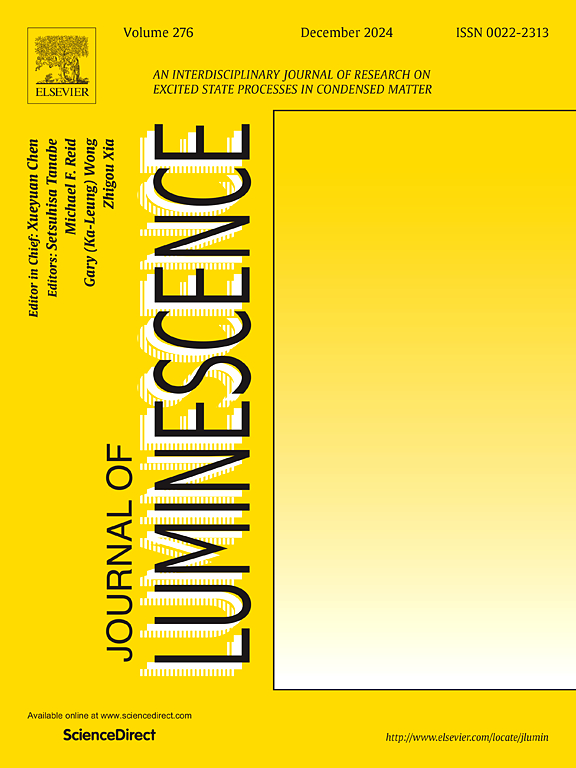Red-emitting Eu3+-doped NaInGe2O6 phosphor for WLEDs: Crystal structure, luminescence properties and thermal stability
IF 3.3
3区 物理与天体物理
Q2 OPTICS
引用次数: 0
Abstract
This article systematically investigates the preparation, structure, and luminescent properties of a novel Eu3+-based germanate phosphor: NaInGe2O6 (NIGO): Eu3+. NIGO: Eu3+ exhibits strong absorption in the near ultraviolet (NUV) and blue region, which enables it to be effectively excited by the blue LED chip. Under 465 nm excitation, NIGO: Eu3+ exhibits a red emission peak at 610 nm, reaching 82.60 % and 68.6 % of the emission intensity of Y3Al5O12 (YAG): Ce3+ and K2TiF6:Mn4+. NIGO: Eu3+ also has good thermal stability, retaining 76.23 % even at 150 °C. Furthermore, combining NIGO: Eu3+ with commercial YAG: Ce3+ phosphors significantly enhances the luminescent performance of blue-chip-excited white light-emitting diodes (WLEDs), including improvements in color rendering index (CRI) and correlated color temperature (CCT). This work indicates that NIGO: Eu3+ phosphors possess promising potential for WLED applications.

发光二极管用Eu3+掺杂的红发NaInGe2O6荧光粉:晶体结构、发光性能和热稳定性
本文系统地研究了一种新型Eu3+基锗酸盐荧光粉NaInGe2O6 (NIGO): Eu3+的制备、结构和发光性能。NIGO: Eu3+在近紫外(NUV)和蓝色区域具有很强的吸收,这使得它能够被蓝色LED芯片有效地激发。在465 nm激发下,NIGO: Eu3+在610 nm处出现红色发射峰,达到Y3Al5O12 (YAG): Ce3+和K2TiF6:Mn4+发射强度的82.60%和68.6%。NIGO: Eu3+也具有良好的热稳定性,即使在150°C时仍保持76.23%。此外,将NIGO: Eu3+与YAG: Ce3+商用荧光粉结合可以显著提高蓝芯片激发白光二极管(wled)的发光性能,包括显色指数(CRI)和相关色温(CCT)的改善。这表明NIGO: Eu3+荧光粉在WLED中具有广阔的应用前景。
本文章由计算机程序翻译,如有差异,请以英文原文为准。
求助全文
约1分钟内获得全文
求助全文
来源期刊

Journal of Luminescence
物理-光学
CiteScore
6.70
自引率
13.90%
发文量
850
审稿时长
3.8 months
期刊介绍:
The purpose of the Journal of Luminescence is to provide a means of communication between scientists in different disciplines who share a common interest in the electronic excited states of molecular, ionic and covalent systems, whether crystalline, amorphous, or liquid.
We invite original papers and reviews on such subjects as: exciton and polariton dynamics, dynamics of localized excited states, energy and charge transport in ordered and disordered systems, radiative and non-radiative recombination, relaxation processes, vibronic interactions in electronic excited states, photochemistry in condensed systems, excited state resonance, double resonance, spin dynamics, selective excitation spectroscopy, hole burning, coherent processes in excited states, (e.g. coherent optical transients, photon echoes, transient gratings), multiphoton processes, optical bistability, photochromism, and new techniques for the study of excited states. This list is not intended to be exhaustive. Papers in the traditional areas of optical spectroscopy (absorption, MCD, luminescence, Raman scattering) are welcome. Papers on applications (phosphors, scintillators, electro- and cathodo-luminescence, radiography, bioimaging, solar energy, energy conversion, etc.) are also welcome if they present results of scientific, rather than only technological interest. However, papers containing purely theoretical results, not related to phenomena in the excited states, as well as papers using luminescence spectroscopy to perform routine analytical chemistry or biochemistry procedures, are outside the scope of the journal. Some exceptions will be possible at the discretion of the editors.
 求助内容:
求助内容: 应助结果提醒方式:
应助结果提醒方式:


